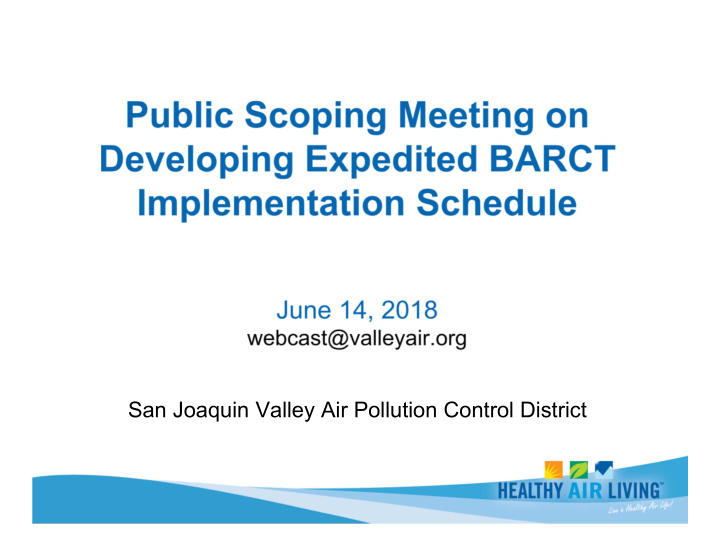



San Joaquin Valley Air Pollution Control District
1. Present the objectives of the proposed project with respect to AB 617 requirements 2. Explain the proposed process to establish an expedited Best Available Retrofit Control Technology (BARCT) evaluation schedule 3. Solicit comments and suggestions from interested stakeholders regarding source categories of interest and associated information 4. Inform all interested parties about upcoming workshop dates, comment periods, and project milestones 2
• September 2017, California extended Cap and Trade and appropriated $1.5 billion in funding • Cap and Trade deal included adoption of AB 617, Nonvehicular Air Pollution: Criteria Air Pollutants and Toxic Air Contaminants • Under AB 617: o Accelerated retrofit of pollution controls on industrial sources o Districts located in non-attainment areas to perform a BARCT analysis of existing rules and regulations, and to propose an expedited schedule for revising rules and implementing BARCT o Additional emissions reporting, monitoring, and reduction plans and implement measures 3
• The Valley is designated as serious nonattainment for the PM2.5 National Ambient Air Quality Standard (NAAQS) and extreme nonattainment for the eight- hour ozone NAAQS • Since 1992, over 600 rules and rule amendments adopted to control emissions from stationary sources • District leads the nation with some of the most stringent NOx emission limits (engines, boilers, turbines, glass-melting furnaces) • New or modified sources of emissions must be equipped with the Best Available Control Technology, which is more stringent than BARCT 4
• BARCT: an air emission limit that applies to existing sources and is the maximum degree of reduction achievable, taking into account environmental, energy and economic impacts by each class or category of source ( CH&SC, Section 40406 ) • Some nonattainment areas with market-based criteria pollutant reduction programs were not requiring BARCT in all cases • Existing stationary sources in San Joaquin Valley subject to BARCT since the 1980s 5
• Must apply to industrial sources subject to state’s Cap and Trade program as of January 1, 2017 • Emissions unit that has implemented BARCT due to a permit revision or a new permit issuance since 2007 not subject to BARCT implementation schedule • Highest priority to permitted units that have not modified emissions-related permit conditions for the greatest period of time • Adopt schedule by Jan 1, 2019 through public process • Implement BARCT schedule by the earliest feasible date, but no later than December 31, 2023 6
• The District has begun implementing BARCT assessment 1. Conducted a survey to identify the facilities subject to the AB 3228 Cap and Trade program: 109 facilities 2. Determined which prohibitory rules apply to these Cap and Trade facilities that need to be evaluated for BARCT: 35 District rules • Future work: o Identify all sources that have implemented BARCT since 2007 o Identify any sources for which a BARCT analysis is required o Identify potential control options for each category, considering: - The local public health and clean air benefits to the surrounding community - The cost-effectiveness of each control option - The air quality and attainment benefits of each control option o Public workshop o Adoption of the expedited BARCT implementation schedule 7
• Scoping Meeting (today) June 14, 2018 Comments due by June 28, 2018 • BARCT Analysis Begin June 18, 2018 3 rd Quarter 2018 • Workshop: • Adopt Expedited BARCT Schedule End of 2018 • BARCT schedule to ARB By January 1, 2019 8
For submitting comments on community identification: errol.villegas@valleyair.org More information available on District website: www.valleyair.org/community Or call for more information: (559) 230-6000 9
• INSERT SURVEY AND SCREENSHOT OF WEBSITE 10
Recommend
More recommend